Page is loading ...

Please read and save these instructions. Read through this owner’s manual carefully before using product. Protect yourself
and others by observing all safety information, warnings, and cautions. Failure to comply with instructions could result in
personal injury and/or damage to product or property. Please retain instructions for future reference.
S & H Industries Inc.
5200 Richmond Road
Cleveland OH 44146
1-800-253-9726
216-831-0550
Service@shindustries.com
www.shindustries.com
Operating Instructions and Parts Manual
High Pressure Abrasive Blast Cabinet
42000

2
42000
Operating Instructions and Parts Manual
High Pressure Abrasive Blast Cabinet
Description
A Perfectly combined traditional abrasive blast cabinet with pressure blaster tank
Provides deeper penetration of abrasive and higher strip rates
Large front opening and work space, accommodates various kinds of work pieces
Foot pedal valve control allows flexible operation and reduces hand fatigue
Large viewing window, L.E.D. lighting and two dust collector provide greater visibility
Specifications and Dimensions
Nozzle Size: 4MM
Nozzle Material: Boron carbide
Maximum Air pressure: 110PSI
CFM: 25 @ 80 PSI with 4MM nozzle
Overall Dimensions: 70”W x 79.5H x 57.8D (95”H with door open)
Working Pressure: 60~110PSI
Abrasive hose: 1”OD – ½” ID
Abrasive grit size: 40-120 with 4MM nozzle
Tank Capacity: 5.4 Gallon
Tank Dimensions: 12.1” x 14.5”
Motor Rating: 110~120V, 60 Hz, 1100W(Each SINGLE MOTOR)
Work Light: LED light 3 Bulbs,20W EACH
Air supply: 1/2” ID air line minimum

3
42000
Operating Instructions and Parts Manual
High Pressure Abrasive Blast Cabinet
General Safety Information
Any blast cabinet will produce a powerful flow of
abrasive particles. To avoid personal injury and
property damage, study this manual thoroughly before
assembling, operating or servicing this blast cabinet.
.
1. During operation, do not expose the hands or
skin directly in the line of the blast nozzle.
2. Ensure all components seal properly after
assembly.
3. Do not exceed the maximum operating pressure
of the blasting equipment
4. Disconnect the cabinet from the air supply before
changing accessories or attempting to install,
service, relocate or perform any maintenance.
5. Check hoses and air lines for weak or worn
condition before each use. Make sure all the
connections are secure before use.
6. Do not point the abrasive blaster nozzle at
anyone or objects.
7. Before installing the machine, consider the
availability and proximity of the required power
supply circuit. If an existing circuit does not meet
the requirements for this machine, a new circuit
must be installed. To minimize the risk of
electrocution, fire, or equipment damage,
installation work and electrical wiring must be
done by an electrician or qualified service
personnel in accordance with all applicable
codes and standards.

4
42000
Operating Instructions and Parts Manual
High Pressure Abrasive Blast Cabinet
Chemicals, including
lead are contained in this product or
its power cord. Wash hands after
handling
Dust can be created when you sweep,
blast, cut, abrasive, drill or grind materials such as
wood, paint, metal, concrete, cement,
or other masonry. This dust often
contains chemicals known to cause
cancer, birth defects, or other
reproductive harm. Wear protective
gear.
Fire or Explosion Hazard! DO NOT
USE a abrasive blaster around combustible or
flammable liquids, dusts, gases, oily rags, or other
materials that can explode or burn quickly. Some
abrasives create sparks when they hit
surfaces. Abrasives similar to
aluminum oxide may generate static
electric sparks which will cause fires or
explosions in an unsafe environment.
Static electric shocks can be painful.
Please wear leather or rubber soled shoes or boots
and stand on the ground to avoid static electricity. A
grounded wire attached to the nozzle
retainer will safely remove the static
electricity.
Operation Method
Connect air and power supply, open
operation door, load abrasive, place work
piece on grate, lock the door, turn dust collectors on
then the air intake valve, adjust working pressure and
step on the foot pedal to start.
Operating Principle
Depressing the foot pedal allows air flow to the
pressure tank, closing the sealing head and
allowing abrasive to flow through the hose.
Opening the gate valve on the tank controls the
flow of abrasive. Open gate valve slowly until
desired abrasive flow is obtained. Note: opening
the gate valve too much will cause pulsing and
can also cause the nozzle to clog. To
depressurize the tank, close the air inlet valve
and depress the foot pedal until pressure gauge
reads zero pressure. When the foot pedal is in
the rest position air flow to the sealing head is
shut off allowing the abrasive to recycle back
into the tank.
Maintenance
NOTE: Disconnect power and air before the
maintenance.
Cleaning: Please clean the machine or parts with a
soft cloth. DO NOT use solvents to clean.
Operation Notice
1. Before operation, check the sealing of the valve,
connecting fitting and hoses and replace when
necessary to ensure safe and reliable
performance.
2. Abrasive should be filtered through a screen to
prevent debris from getting into the tank, gate
valve or nozzle.
3. Do not add too much abrasive. Adding too much
abrasive may cause the sealing head not to seal
properly.
4. If abrasive stops flowing, disengage from foot
pedal to allow abrasive to flow back into the
pressure pot.
5. Use good quality, dry abrasives that are designed
to be recycled. Keep abrasives dry. Moisture will
cause clogging and flow problems. Replace
abrasive when abrasive breaks down. Worn
abrasive will cause decreased strip rates. DO
NOT USE SAND!
6. To change abrasive, place nozzle end of the
hose in a woven bag and depress the foot pedal
until all abrasive is removed from the unit.
7. Discharge water separator as needed. Minimum
1-2 times daily.
8. Clean dust collector filters as needed. Under
certain dusty conditions the filters may need to be
cleaned multiple times during a 6 hour cycle.
Failure to clean will cause dust collector motors
to overheat and this condition is not covered
under warranty.
9. Do periodical inspection for the sealing head for
any possible damage, aging, deformation;
sealing leaking will affect abrasive blast pressure
and results to air loss.
10. When you finish, clean all abrasive out in order to
prevent breakdown for next operation. Store
abrasives in a dry location.
11. Avoiding clog: Keep media dry! Nozzle size
needs to be 3-4 times larger than the size of
the abrasive being used.
.

5
42000
Operating Instructions and Parts Manual
High Pressure Abrasive Blast Cabinet

6
42000
Operating Instructions and Parts Manual
High Pressure Abrasive Blast Cabinet
Assembly
1. Fasten the four legs and the
Leg Reinforcements to the Bracket
by using M8*20mm bolt, Flat
Washer, lock Washer and M8 Nut,
tighten.
Hardware
2. Assemble the Left Bar, Right Bar,
Control Panel and Rear Bar by using
M6*12mm bolt, Flat Washer, and M6
Nut in sequence.
Hardware

7
42000
Operating Instructions and Parts Manual
High Pressure Abrasive Blast Cabinet
3. Place the funnel as shown in the
diagram. Attach the tank assembly
(including bolt, flat washer, lock
washer, nut) and rubber seal onto
the funnel.
Note: Locate tank service port with
right side funnel on same direction.
Hardware
3: Assemble discharge hose with #9
Cylinder Block for tank
#9 Cylinder Block for tank

8
42000
Operating Instructions and Parts Manual
High Pressure Abrasive Blast Cabinet
Stand the lower assembly upright as shown, locate #9 Cylinder Block for tank in the
rear, and then assemble #52 abrasive hose with tee joint and install the discharge
hose through the rubber retainer as shown.
Assemble #52 abrasive hose with tee joint
#9 Cylinder Block for tank

9
42000
Operating Instructions and Parts Manual
High Pressure Abrasive Blast Cabinet
Place #6 grid cover, insert discharge hose into the protective cover.
Rubber seal

10
42000
Operating Instructions and Parts Manual
High Pressure Abrasive Blast Cabinet
1:There are two 8mm hoses (color orange and blue) from Electromagnetic valve 2 (#3) on control
panel, connect with the two adaptors for #9 Cylinder Block for tank , as shown in diagram H2-
C2;H3-C3
2: There is a orange hose (16mm) from Electromagnetic valve 1(#2) on control panel, connect
with #21 G1/2″-16 Straight for tank ,like the picture H4-C4 Note: The hose must be securely
inserted in to the fitting. To release hose push plastic ring inward. Failure to connect hoses to the
proper fittings will cause the blaster to not to operate properly.
Electromagnetic valve 2 (#3)
Electromagnetic valve 1
#9 Cylinder Block for tank
#21 G1/2″-16 Straight
Coupling

11
42000
Operating Instructions and Parts Manual
High Pressure Abrasive Blast Cabinet
Assemble right bar and rear bar and legs with
M6X12MM bolt and M6 nut, and then install the
PSA foam to the funnel a shown.
PSA Foam

12
42000
Operating Instructions and Parts Manual
High Pressure Abrasive Blast Cabinet
Place the grid on the funnel, with assistance
place cabinet assembly on the lower assembly,
while lining up the holes, open the door,
assemble cabinet assembly and funnel with
M6X16MM bolts and 6 flat washers

13
42000
Operating Instructions and Parts Manual
High Pressure Abrasive Blast Cabinet
#4 Abrasive tee joint
1: Open the door, Insert abrasive hose through rubber retainer , adjust the
abrasive hose ,avoid sharp bends to help prevent excessive wearing of the
abrasive hose , next secure the abrasive hose with hose clamp( use
M6X12mm bolts and M6 nut)
2: Assemble abrasive hose and #4 abrasive tee joint, seal thread with Teflon
tape.

14
42000
Operating Instructions and Parts Manual
High Pressure Abrasive Blast Cabinet
Install nozzle retainer to end of the abrasive hose, fasten the abrasive hose
with 4.2 * 10MM self tapping screws

15
42000
Operating Instructions and Parts Manual
High Pressure Abrasive Blast Cabinet
Attach the two dust collectors #20 on both sides
of the cabinet assembly #1 with M6*12 bolts
(8PCS). Note: The longer electrical cord on left
side dust collector allowing cord to reach power
box.

16
42000
Operating Instructions and Parts Manual
High Pressure Abrasive Blast Cabinet
Stand & Cabinet Base
13-1:Assemble stand with M8*45mm bolt ,M8 Nut ,8 flat washer, 8 lock
washer, see above diagram
13-2: Install stand to front legs of cabinet as
shown in the diagram with M8*45mm
bolt, M8 Nut ,8 flat washer,8 lock
washer.

17
42000
Operating Instructions and Parts Manual
High Pressure Abrasive Blast Cabinet
14. Plug the Electromagnetic Valve Plug and Foot Pedal Plug into the
Power Supply. (Note the label on the power supply)

18
42000
Operating Instructions and Parts Manual
High Pressure Abrasive Blast Cabinet
Sealing Head Replacement Graphics:
Closure Gasket

19
42000
Operating Instructions and Parts Manual
High Pressure Abrasive Blast Cabinet
Wiring Diagram

20
42000
Operating Instructions and Parts Manual
High Pressure Abrasive Blast Cabinet
Troubleshooting
Symptom(s)
Possible Causes(s)
Possible Solution(s)
Intermittent, clogging, or no media
spray at the nozzle
No more media in the pressure
tank.
1. Release foot pedal to let media
flow back from funnel to
pressure tank.
Nozzle has been clogged by a
contaminant.
1. Close air source, remove the
nozzle, and remove
contaminant. Repeat the same
procedure at the bottom of the
pressure tank by removing the
valve and fitting to clear
contaminant.
2. Make sure that the media is not
worn-out, saturated with debris,
or contaminated with moisture
causing it to cake. Screen or
replace media as required.
Too much or too less media
1. Rotating the gate valve under
the pressure tank. If too much
media, rotate clockwise;
otherwise, counterclockwise.
2. Check nozzle for wear, replace
as needed.
Sealing head air-leaking
Closure Gasket or sealing head
worn out
1. Open maintenance cover to
change closure gasket or
sealing head inside.
Sealing head cannot move up and
down
Too much media
1. Discharge part of abrasive from
the tank.
2. Tap on sealing head to release
/




